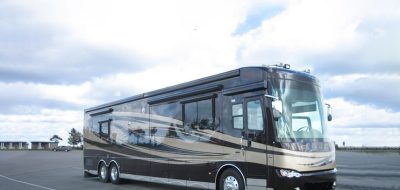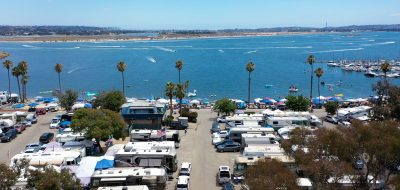Sedona is an Arizona destination not to be missed—a must-see wonders.

Sedona has developed into a center for traditional and contemporary arts and offers a variety of galleries, boutiques, and specialty shops. © Rex Vogel, all rights reserved
Sedona easily makes the “A” list of RV destinations in the U.S. due to its rugged western appeal and colorful rock formations. Tourists come from around the world to absorb the natural wonders of Red Rock Country and Sedona, its centerpiece.
Located at the base of Oak Creek Canyon, another scenic destination, Sedona is renowned for its stunning rock formations such as Coffee Pot Rock, Cathedral Rock, and Courthouse Butte, as well as its surrounding lush forests. Sedona is located in both Coconino and Yavapai Counties and is surrounded by Coconino National Forest.
Sedona has developed into a center for traditional and contemporary arts and offers a variety of galleries, boutiques, and specialty shops.
In 1950, surrealist painter Max Ernst moved to Sedona, and other famous artists followed. Many artists have been attracted to Sedona and its rugged beauty which is said to enhance their creativity. Over the years, an artist colony has developed in Sedona and many of the artists sell their work in local galleries and shops.
Words alone cannot adequately describe this part of the country. Exhilarating nature! Scary excitement! Spiritual renewal! The sun and the moon! Incredible historic stories of wisdom and strength! The wild animals, birds, and flora! And of course, art! All are surrounded by azure blue skies and clean air.
Sedona’s mesmerizing red-rock country is unique to the world. The Sedona community offers so much—history, archeology, arts, culture, hiking, biking, off-road adventure, and spiritual and metaphysical meditations.

Finished in 1956, Chapel of the Holy Cross sits atop a pinnacle 250 feet above the valley floor. © Rex Vogel, all rights reserved
It is believed by many that the region of Sedona contains a concentration of vortexes which are spots that release psychic energy or power from the Earth.
Positively charged vortexes are said to have feminine attributes: nurturing, calming, tranquil, or yin. Negative vortexes are masculine, active, energizing, or yang.
There are four local points which are considered to be energy vortexes in Sedona: Cathedral Rock (positive-feminine), Bell Rock (negative-masculine), Airport Mesa (negative-masculine), and Boynton Canyon (a balance of both energies).
For me, all of Sedona and Red Rock Country is one big vortex, a magnetic force that draws me back to this enchanting land year after year.
Sedona offers it all in a picturesque backdrop of serenity contrasted by some of the most rugged terrain to be found in The West.
Amid the red mountains and stunning views, Sedona offers the very finest resort facilities to visitors. This mostly upscale community has more quaint shops and restaurants than many cities twice its size, yet high-rise buildings and big-box stores are not permitted to blight the view anywhere in Sedona. Local zoning laws are so strict that all new businesses must be built in the adobe style that melds into the background.
Since the red rocks are not all clustered in one place, nor can they all be seen from one location, visitors can fan out from Sedona on their own or can take a guided tour. Numerous four-wheel-drive vehicle rental companies with or without drivers and guides provide opportunities to leave town far behind and traverse rocky winding trails. Just remember not to get lost—there are passes and canyons that would make a pack mule faint.
Before it became a backdrop for Western movies, Sedona was a sleepy town of farmers, know for the quality of its fruit, especially the abundant apple orchards. Today, the city of 15,000 nestled within the red rocks attracts four million new and returning visitors each year, making it the second-most-visited place in Arizona, after the Grand Canyon.
Awash in a sea of brilliant red rock, exotic Sedona captures Arizona’s bygone days as well as its natural beauty.

Nestled within the red rocks, Sedona attracts four million new and returning visitors each year, making it the second-most-visited place in Arizona, after the Grand Canyon. © Rex Vogel, all rights reserved
The story about how Sedona was named is well known; nonetheless, a brief telling seems appropriate. As the story goes, in 1901, a young adventurous couple, Theodore Carl Schnebly and his wife, left Gorin, Missouri seeking new fortunes in the wilds of the Northern Arizona Territory.
They settled along the banks of Oak Creek below towering cliffs of red sandstone. Cypress and cottonwood trees provided an oasis of greenery and shade from the simmering desert heat. The family labored to create orchards and a large frontier home, which became the community’s hotel for travelers passing through the raw but enchanting land.
To establish a post office at his homestead, Carl Schnebly submitted the names Oak Creek Crossing and Schnebly Station to the postmaster general in Washington, D.C., who promptly turned him down. The suggestions were too lengthy to fit on a cancellation stamp.
Following a suggestion by his brother, Dorsey Ellsworth Schnebly, he submitted the unusual name of his young wife, Sedona—and travelers today remain captivated by Sedona, Arizona.
Details
Travelers in Arizona can visit az511.gov or dial 511 to get information on road closures, construction, delays, weather and more.
Related
Worth Pondering…
There are only two places in the world
I want to live—Sedona and Paris.
—Max Ernst, Surrealist painter
You May Also Like
- Newmar Introduces First 3D TV
- 2011 National Park Holiday Celebrations
- Drought Impacts Texas State Park Revenue
- Forest River Introduces Luxury Aviator Travel Trailer
- Heartland Introduces Torque Toy Haulers
- MVP Introduces Zero Emission Class C Motorhome
If you enjoy these articles and want to read more on RV travels and lifestyle, visit my website: Vogel Talks RVing.







Patti Faustini
Hi Rex, those are seriously gorgeous photos of Sedona…and I’ve looked at tons of photos. Nice work!
Happy tales,
Patti